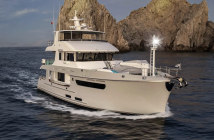Whether you are looking to add radar to your boat or it’s just time to replace an old and out of date unit, there are a lot of considerations that should go into the decision-making process.
To start, you need to be certain that a new or replacement radar is compatible with your existing marine electronics. In other words, will the radar display appear on your multifunction display so you can overlay the images onto the digital chart. For simplicity’s sake, it makes sense to stick with one brand for all electronics.
The size of radar you choose depends on how far you need to see and the height above the water for mounting the unit. For most cruisers, a 24-mile range radar will be more than sufficient.
Do you want or need a guard zone function? This is invaluable when running at night with a small crew, particularly in congested shipping lanes. Also, when anchored on a stormy night, the guard zone will alert you to a dragging anchor or to another boat dragging down onto you.
The next big decision will be the choice between traditional pulse-style and the newer solid-state, broadband radars. Both have their advantages and disadvantages.
In brief, pulse radar and CHIRP technology has been so improved that the modern units do just about everything that the solid-state radars do and provide superior signal strength at long ranges. They also consume more energy.
Digital or solid-state radars do not require a warm-up time and will turn on instantly. They are more energy efficient than pulse radars and they provide superior images at short ranges. This is particularly useful when navigating through narrow channels in fog or at night.
Read a good basic guide to radar in 2025 on the West Marine Advisor here.




